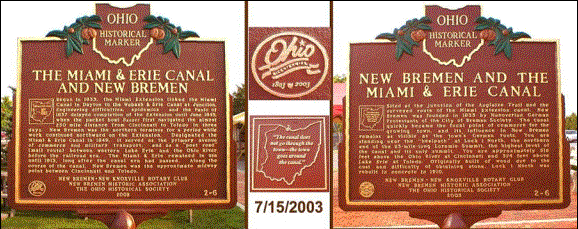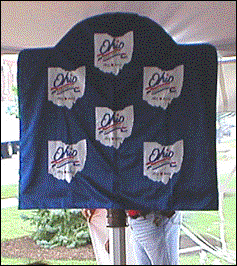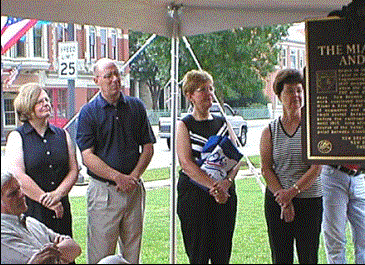No products

At 12:00 noon July 15, 2003, this historical marker was dedicated at Lock One Park at the corner of St. Rt. 66 & St. Rt. 274 to highlight the significance of New Bremen, Ohio and the Miami & Erie Canal in Ohio’s bicentennial year.
The north side of the marker reads:
THE MIAMI & ERIE CANAL AND NEW BREMEN
Begun in 1833, the Miami Extension linked the Miami Canal in Dayton to the Wabash & Erie Canal at Junction. Engineering difficulties, epidemics, and the Panic of 1837 delayed completion of the Extension until June 1845, when the packet boat Banner first navigated the almost 250 mile distance from Cincinnati to Toledo in three days. New Bremen was the northern terminus for a period while work continued northward on the Extension. Designated the Miami & Erie Canal in 1849, it served as the primary avenue of commerce and military transport, and as a “post road” (mail route) between western Lake Erie and the Ohio River before the railroad era. The Miami & Erie remained in use until 1913, long after the canal era had passed. Along the course of the canal, New Bremen was the approximate midway point between Cincinnati and Toledo.
NEW BREMEN - NEW KNOXVILLE ROTARY CLUB
NEW BREMEN HISTORIC ASSOCIATION
THE OHIO HISTORICAL SOCIETY
2003
The south side of the marker reads:
NEW BREMEN AND THE MIAMI & ERIE CANAL
Sited at the junction of the Auglaize Trail and the surveyed route of the Miami Extension canal, New Bremen was founded in 1833 by Hanoverian German Protestants of the City of Bremen Society. The canal quickly became the focal point of commerce for the growing town, and its influence in New Bremen remains as visible as the town’s German roots. You are standing near the “heelpath” at Lock 1 North, the northern end of the 23-mile-long Loramie Summit, the highest level of the canal and its only summit. You are approximately 516 feet above the Ohio River at Cincinnati and 374 feet above Lake Erie at Toledo. Originally built of wood due to the cost and difficulty of obtaining stone, Lock 1 North was rebuilt in concrete in 1910.
NOTE: The “heelpath” of the canal is the opposite of the towpath.
NEW BREMEN - NEW KNOXVILLE ROTARY CLUB
NEW BREMEN HISTORIC ASSOCIATION
THE OHIO HISTORICAL SOCIETY
2003
The Ohio historical marker program, begun in 1953 during Ohio’s sesquicentennial, enables Ohioans to commemorate and celebrate local history and to learn more about significant events and places in Ohio. Designed to be permanent and highly visible, the historic markers are large cast-aluminum signs that tell stories about aspects of Ohio’s history and pre-history.
This sign was commissioned and funded by the New Bremen-New Knoxville Rotary Club and the New Bremen Historic Association. Doug Harrod and his son-in-law, Darrin Klinger, did the research and applied to the Ohio Historical Society for the marker.
Participating in the dedication program were: Doug Harrod (N.B. Chief of Police), Bob Klein (Mayor), Delores Stienecker (Curator of the N.B.H.A. Museum), Tom Fledderjohann (N.B./N.K. Rotary Club), J.D. Britton (Ohio Historical Society), Derrick Seaver (State Representative), Jim Jordan (State Senator), and Darrin Klinger (Historical Researcher). The marker was unveiled by four retired New Bremen school teachers – Gary & Margery Stueve, Rosemary Wermert and Sally Dicke. (see pictures below)


DELORES STIENECKER’S MESSAGE
“As a member of the New Bremen Historic Association, I extend greetings to everyone assembled for this dedication.
Our German forefathers came to this area and brought with them a reasonable amount of wealth. The money was used to purchase the land. Along with wealth, they also brought a hard work ethic. They were farmers and bankers. They built flour and lumber mills, set up small businesses and brought their trades. They had bakeries & breweries, they cut marble and ice. But most of all they brought richness of visions and dreams.
The opening of the Miami & Erie Canal brought prosperity to New Bremen. The canal was the avenue to ship our commodities such as hogs, flour, beer and ice to the larger cities along its thoroughfare. These boats brought salesmen into our area, along with supplies and equipment needed here.
The members of the New Bremen Historic Association are proud of our heritage. Hopefully we will continue to bring a wealth of people to New Bremen in the form of tourism. I extend an invitation to all to visit our museum during our visiting hours to see pictures and artifacts of the canal and other items being preserved for future generations.”
[from “The Towpath” – October 2003 (Bicentennial issue)]

